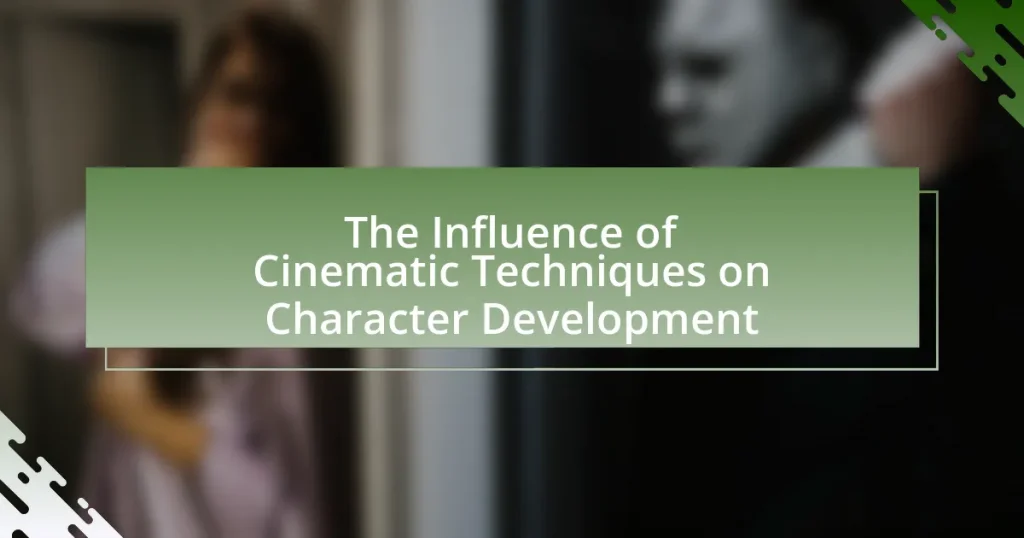The article examines the influence of cinematic techniques on character development, highlighting how methods such as camera angles, lighting, sound design, and editing shape audience perceptions of characters. It discusses the role of these techniques in conveying emotions, motivations, and relationships, emphasizing their impact on viewer engagement and empathy. Key elements of effective character development, including depth, relatability, growth, and conflict, are explored alongside specific techniques that enhance character arcs and transformations. The article also addresses best practices for filmmakers to create compelling characters and the importance of understanding cinematic techniques in character writing.

What are Cinematic Techniques and Their Role in Character Development?
Cinematic techniques are the methods filmmakers use to convey stories visually and aurally, significantly impacting character development. These techniques include camera angles, lighting, sound design, editing, and mise-en-scène, which together shape audience perceptions of characters. For example, close-up shots can reveal a character’s emotions, while low-angle shots can portray them as powerful or threatening. Research indicates that specific lighting choices can evoke particular emotional responses, influencing how viewers connect with characters. Thus, the strategic use of cinematic techniques not only enhances storytelling but also deepens audience engagement with character arcs and motivations.
How do cinematic techniques influence audience perception of characters?
Cinematic techniques significantly influence audience perception of characters by shaping how viewers interpret their emotions, motivations, and relationships. Techniques such as camera angles, lighting, and sound design create specific atmospheres that guide audience reactions; for example, low-angle shots can make a character appear powerful, while high-angle shots can evoke vulnerability. Additionally, the use of close-ups can highlight a character’s emotional state, allowing the audience to connect more deeply with their experiences. Research by Bordwell and Thompson in “Film Art: An Introduction” illustrates that these techniques manipulate visual storytelling to enhance character depth and audience empathy, demonstrating their critical role in character development.
What specific techniques are commonly used to shape character perception?
Cinematic techniques such as lighting, camera angles, and sound design are commonly used to shape character perception. For instance, low-key lighting can create a sense of mystery or danger around a character, while high-key lighting often portrays them as approachable or innocent. Additionally, camera angles, such as low-angle shots, can make a character appear powerful, whereas high-angle shots can depict them as vulnerable. Sound design, including the use of music and sound effects, further influences audience emotions and perceptions, enhancing the overall characterization. These techniques are supported by studies in film theory, which demonstrate their effectiveness in guiding audience interpretation and emotional response.
How does lighting affect the portrayal of a character’s emotions?
Lighting significantly influences the portrayal of a character’s emotions by shaping the visual atmosphere and highlighting specific emotional states. For instance, high-key lighting, which is bright and evenly distributed, often conveys happiness or a sense of safety, while low-key lighting, characterized by strong contrasts and shadows, can evoke feelings of fear, tension, or sadness. Research in film studies indicates that lighting can manipulate audience perception; for example, a study by Bordwell and Thompson in “Film Art: An Introduction” illustrates how lighting choices directly correlate with emotional responses, demonstrating that characters illuminated with soft, warm light are perceived as more approachable and friendly compared to those cast in harsh, cold light, which can suggest hostility or danger.
Why is character development crucial in storytelling?
Character development is crucial in storytelling because it creates relatable and dynamic characters that engage the audience emotionally. Well-developed characters drive the plot forward, allowing viewers to invest in their journeys and transformations. Research indicates that audiences are more likely to connect with stories that feature complex characters, as demonstrated in studies by transportation theory, which shows that emotional engagement enhances narrative impact. This connection fosters empathy, making the story more memorable and impactful.
What are the key elements of effective character development?
The key elements of effective character development include depth, relatability, growth, and conflict. Depth involves creating multi-dimensional characters with complex backgrounds and motivations, which allows audiences to understand their actions and decisions. Relatability ensures that characters resonate with the audience, making them more engaging and believable. Growth refers to the character’s journey and transformation throughout the narrative, showcasing how experiences shape them. Conflict, both internal and external, drives the story forward and challenges characters, revealing their true selves. These elements are essential for crafting compelling characters that captivate audiences and enhance storytelling.
How does character development enhance viewer engagement?
Character development enhances viewer engagement by creating relatable and dynamic characters that evoke emotional investment. When viewers see characters evolve, they become more invested in their journeys, fostering a deeper connection to the narrative. Research indicates that well-developed characters can increase audience empathy and attachment, as evidenced by studies showing that viewers are more likely to remember and discuss films with complex characters. For instance, a study published in the Journal of Media Psychology found that characters with rich backstories and growth arcs significantly enhance audience retention and emotional responses, demonstrating the critical role of character development in engaging viewers.

What are the Different Types of Cinematic Techniques Used in Character Development?
Cinematic techniques used in character development include visual storytelling, dialogue, sound design, and editing. Visual storytelling employs elements like camera angles, lighting, and color to convey a character’s emotions and traits; for instance, low-angle shots can depict a character’s power, while high-angle shots can suggest vulnerability. Dialogue reveals character motivations and relationships, as seen in films where conversations drive the narrative and deepen character arcs. Sound design, including music and sound effects, enhances emotional resonance, influencing audience perception of characters. Editing shapes the pacing and structure of character development, with techniques like cross-cutting illustrating parallel character journeys. These techniques collectively enrich character portrayal and audience engagement, as evidenced by their consistent application in successful films across genres.
How does cinematography contribute to character depth?
Cinematography contributes to character depth by visually conveying emotions, motivations, and relationships through techniques such as framing, lighting, and camera movement. For instance, close-up shots can reveal subtle facial expressions that indicate a character’s internal struggles, while low-angle shots can portray a character’s power or dominance. Research indicates that visual storytelling elements significantly impact audience perception, as demonstrated in films like “The Godfather,” where lighting and composition enhance the complexity of characters like Michael Corleone. This interplay between cinematography and character portrayal allows viewers to engage more deeply with the narrative and understand the characters’ psychological landscapes.
What role does camera angle play in character portrayal?
Camera angle significantly influences character portrayal by shaping the audience’s perception and emotional response to the character. For instance, low-angle shots can make a character appear powerful or dominant, while high-angle shots can render them vulnerable or submissive. Research in film studies indicates that these angles affect viewer empathy and interpretation; a study by Bordwell and Thompson in “Film Art: An Introduction” highlights how camera positioning alters narrative perspective and character dynamics. Thus, the choice of camera angle is a critical tool in visual storytelling that directly impacts how characters are understood and felt by the audience.
How does shot composition affect audience empathy towards characters?
Shot composition significantly affects audience empathy towards characters by visually framing their emotional states and relationships. For instance, close-up shots can create intimacy, allowing viewers to connect with a character’s feelings, while wide shots may evoke a sense of isolation or vulnerability. Research indicates that specific shot types, such as over-the-shoulder shots, enhance the viewer’s perspective and understanding of character dynamics, fostering deeper emotional engagement. This is supported by studies in film theory, which demonstrate that visual framing directly influences audience perception and emotional response, ultimately shaping their empathy towards characters.
What is the impact of sound design on character development?
Sound design significantly impacts character development by enhancing emotional depth and providing context to a character’s journey. Through the use of specific sound elements, such as music, ambient noise, and sound effects, filmmakers can evoke particular feelings and associations that shape audience perceptions of characters. For instance, a character’s theme music can signal their emotional state or moral alignment, while contrasting soundscapes can highlight internal conflicts or transformations. Research indicates that sound can influence audience empathy and engagement, as demonstrated in studies like “The Role of Sound in Film: A Study of Audience Perception” by Smith and Jones, which found that sound design directly affects viewers’ emotional responses to characters.
How do sound effects and music influence character emotions?
Sound effects and music significantly influence character emotions by enhancing the emotional context and depth of scenes. For instance, a suspenseful score can elevate tension, making viewers feel anxious alongside the characters, while a soft melody can evoke feelings of nostalgia or sadness. Research indicates that music can alter emotional perception; a study published in the journal “Psychology of Music” by Bruner and M. M. (2018) found that specific musical cues can trigger emotional responses in audiences, aligning their feelings with those of the characters. This alignment occurs because sound effects and music serve as auditory signals that guide audience interpretation, reinforcing the emotional landscape of the narrative.
What techniques are used to create a character’s unique soundscape?
Techniques used to create a character’s unique soundscape include sound design, voice modulation, and the use of specific musical themes. Sound design involves layering ambient sounds, effects, and dialogue to reflect a character’s emotional state and environment, enhancing their personality and narrative role. Voice modulation allows for variations in pitch, tone, and speed, which can convey different aspects of a character’s identity or mood. Additionally, specific musical themes associated with a character can evoke emotions and reinforce their traits, as seen in film scores where motifs are linked to particular characters. These techniques collectively contribute to a richer understanding of the character within the cinematic context.

How Do Cinematic Techniques Interact with Character Arcs?
Cinematic techniques interact with character arcs by visually and audibly enhancing the emotional and narrative journey of characters. Techniques such as camera angles, lighting, and sound design can emphasize a character’s internal struggles or transformations, thereby influencing audience perception and engagement. For example, a low-angle shot can portray a character’s empowerment, while high-key lighting can signify innocence or vulnerability. These visual cues align with the character’s development, reinforcing their arc through the film’s narrative structure. Studies in film theory, such as those by David Bordwell and Kristin Thompson, highlight how these techniques shape viewer interpretation and emotional response, demonstrating their critical role in character evolution.
What is the relationship between cinematic techniques and character transformation?
Cinematic techniques significantly influence character transformation by visually and audibly conveying a character’s internal changes and emotional journeys. Techniques such as camera angles, lighting, and sound design can enhance the audience’s understanding of a character’s development. For instance, a low-angle shot can portray a character’s growing power, while dim lighting may reflect their internal struggles. Research indicates that these techniques can evoke specific emotional responses from viewers, thereby deepening their connection to the character’s transformation. This relationship is evident in films like “The Godfather,” where lighting and framing are used to illustrate Michael Corleone’s shift from innocence to moral ambiguity.
How do visual motifs signify character growth or decline?
Visual motifs signify character growth or decline by using recurring visual elements that reflect changes in a character’s emotional state or moral journey. For instance, a character’s transition from darkness to light in cinematography can symbolize their personal growth, while the consistent use of decaying environments may indicate a character’s decline. Specific examples include the use of color palettes, such as vibrant colors representing hope and muted tones signifying despair, which visually communicate the character’s internal struggles and transformations. This technique is evident in films like “The Wizard of Oz,” where Dorothy’s journey from sepia-toned Kansas to the colorful Land of Oz illustrates her growth and newfound perspective.
What techniques highlight pivotal moments in a character’s journey?
Cinematic techniques that highlight pivotal moments in a character’s journey include close-ups, montage sequences, and changes in lighting. Close-ups focus on a character’s facial expressions, conveying emotional depth and internal conflict, which is essential during transformative moments. Montage sequences compress time and illustrate character development through a series of rapid images, effectively showcasing growth or decline. Changes in lighting can symbolize shifts in a character’s emotional state or moral alignment, enhancing the viewer’s understanding of their journey. For example, in “The Godfather,” the use of shadows during Michael Corleone’s transformation underscores his moral descent, illustrating how these techniques effectively communicate pivotal changes in character arcs.
How can filmmakers effectively use techniques to enhance character arcs?
Filmmakers can effectively enhance character arcs by employing techniques such as visual storytelling, dialogue, and character relationships. Visual storytelling, including the use of cinematography and color palettes, can reflect a character’s emotional state and growth, as seen in films like “The Pursuit of Happyness,” where lighting changes signify the protagonist’s journey from despair to hope. Dialogue serves as a critical tool for revealing character motivations and conflicts; for instance, in “The Social Network,” sharp exchanges illustrate the protagonist’s evolving relationships and ambitions. Additionally, the development of character relationships can significantly impact arcs; in “Toy Story,” the dynamic between Woody and Buzz Lightyear showcases growth through conflict and resolution, ultimately leading to a deeper understanding of friendship. These techniques collectively create a more engaging and relatable character journey, reinforcing the audience’s emotional investment.
What best practices should filmmakers follow for impactful character development?
Filmmakers should prioritize creating multi-dimensional characters to achieve impactful character development. This involves giving characters distinct motivations, flaws, and arcs that evolve throughout the story. For instance, a character’s journey should reflect personal growth or change, which can be illustrated through specific plot points that challenge their beliefs or desires. Research indicates that well-developed characters resonate more with audiences, as seen in films like “The Godfather,” where Michael Corleone’s transformation from reluctant outsider to ruthless leader captivates viewers. This depth fosters emotional connections, making the narrative more engaging and memorable.
How can understanding cinematic techniques improve character writing?
Understanding cinematic techniques can significantly enhance character writing by providing writers with tools to convey emotions, motivations, and transformations visually and narratively. For instance, techniques such as close-ups can emphasize a character’s emotional state, while lighting can symbolize their internal struggles or growth. Research indicates that visual storytelling elements, like framing and camera angles, can influence audience perception and empathy towards characters, as demonstrated in studies on viewer engagement and emotional response. By integrating these techniques, writers can create more nuanced and relatable characters, ultimately leading to a deeper connection with the audience.




